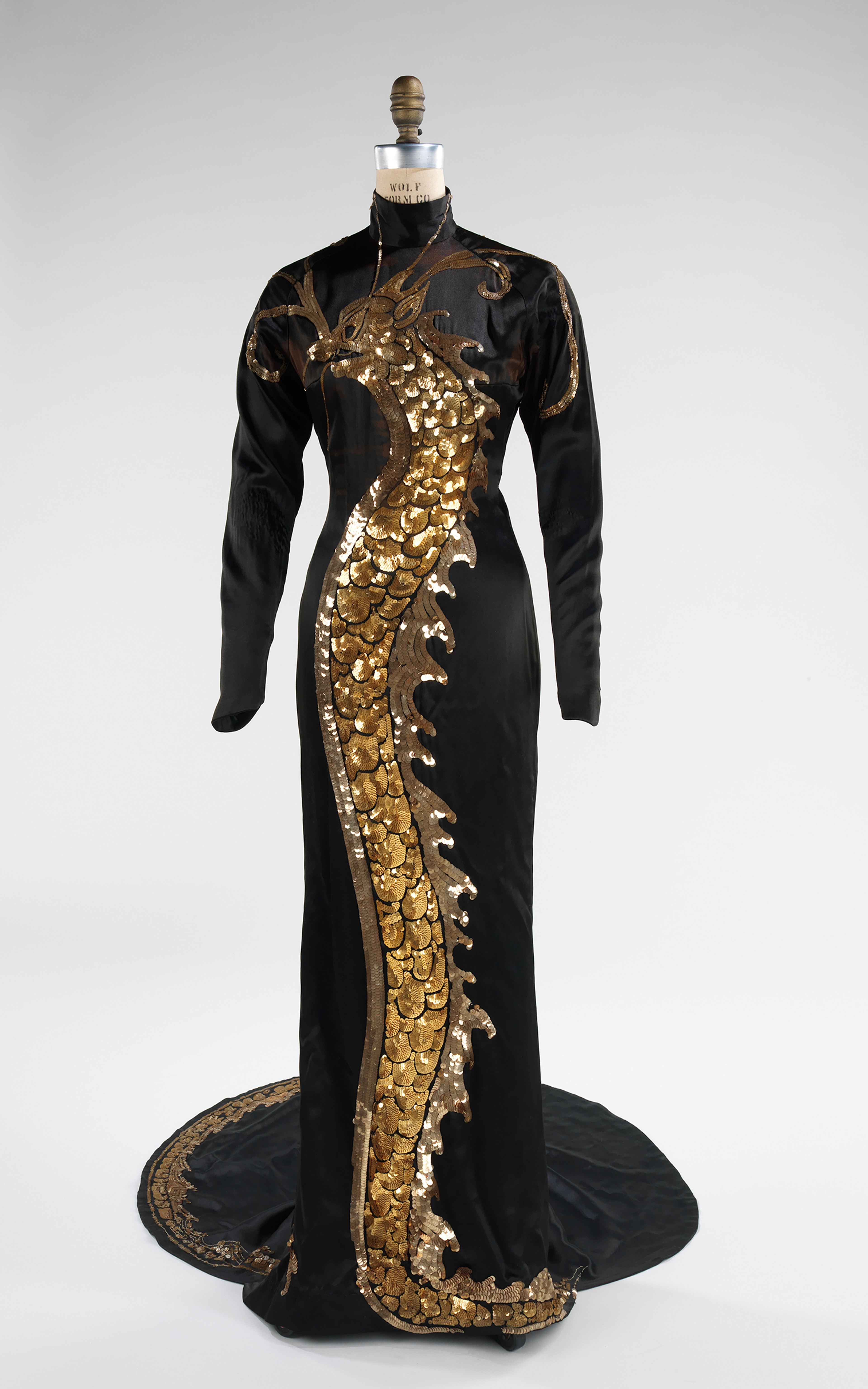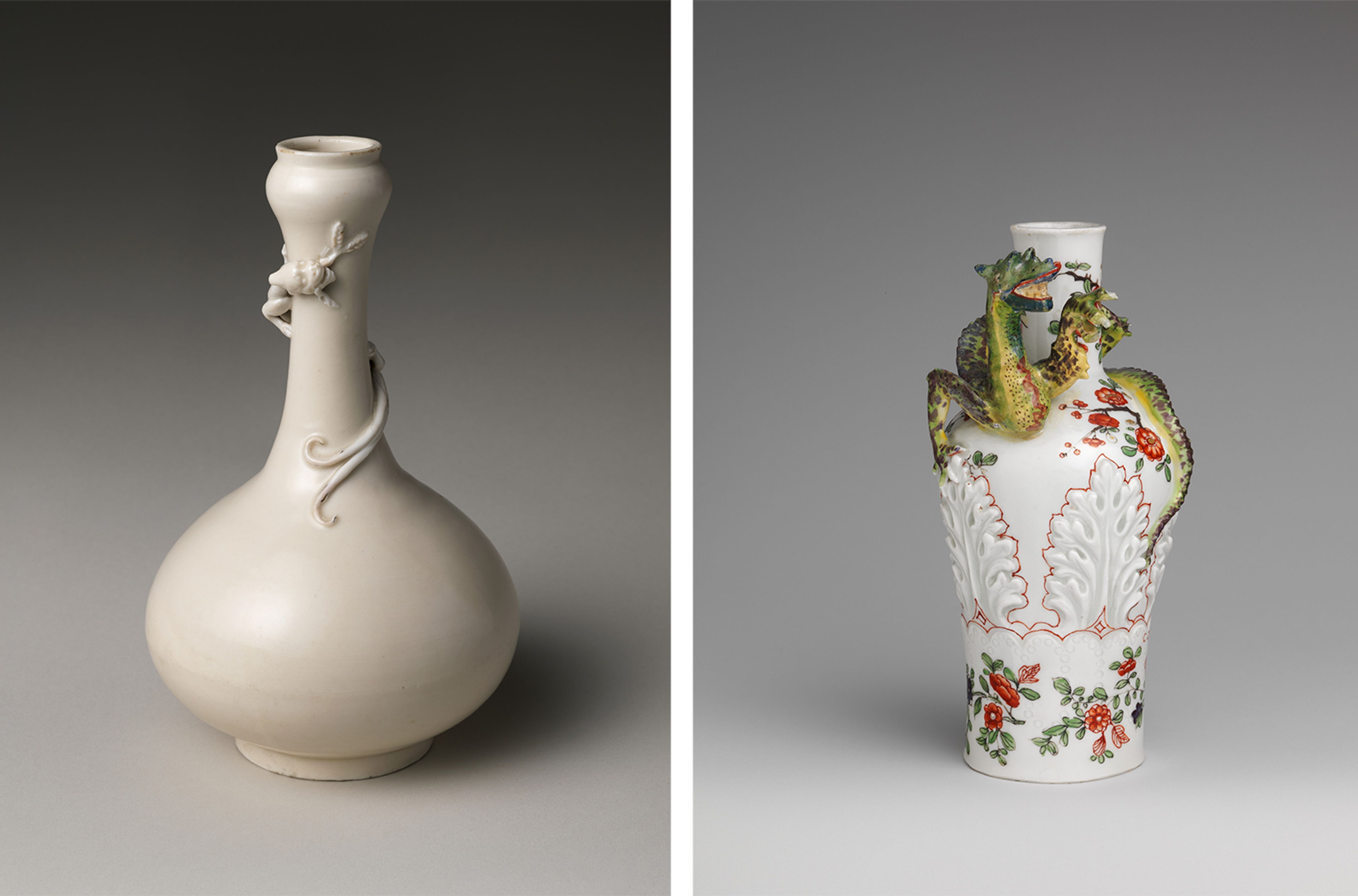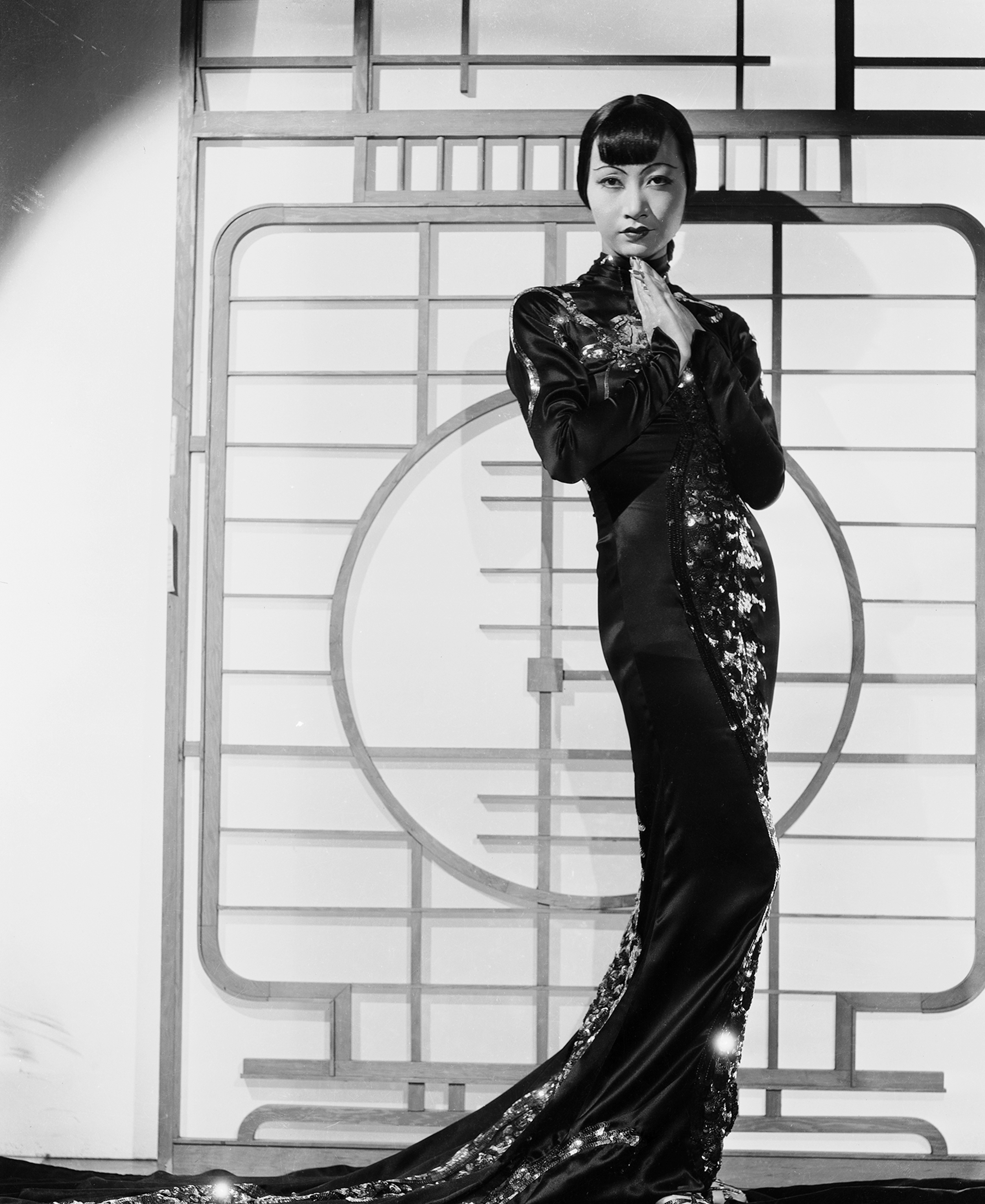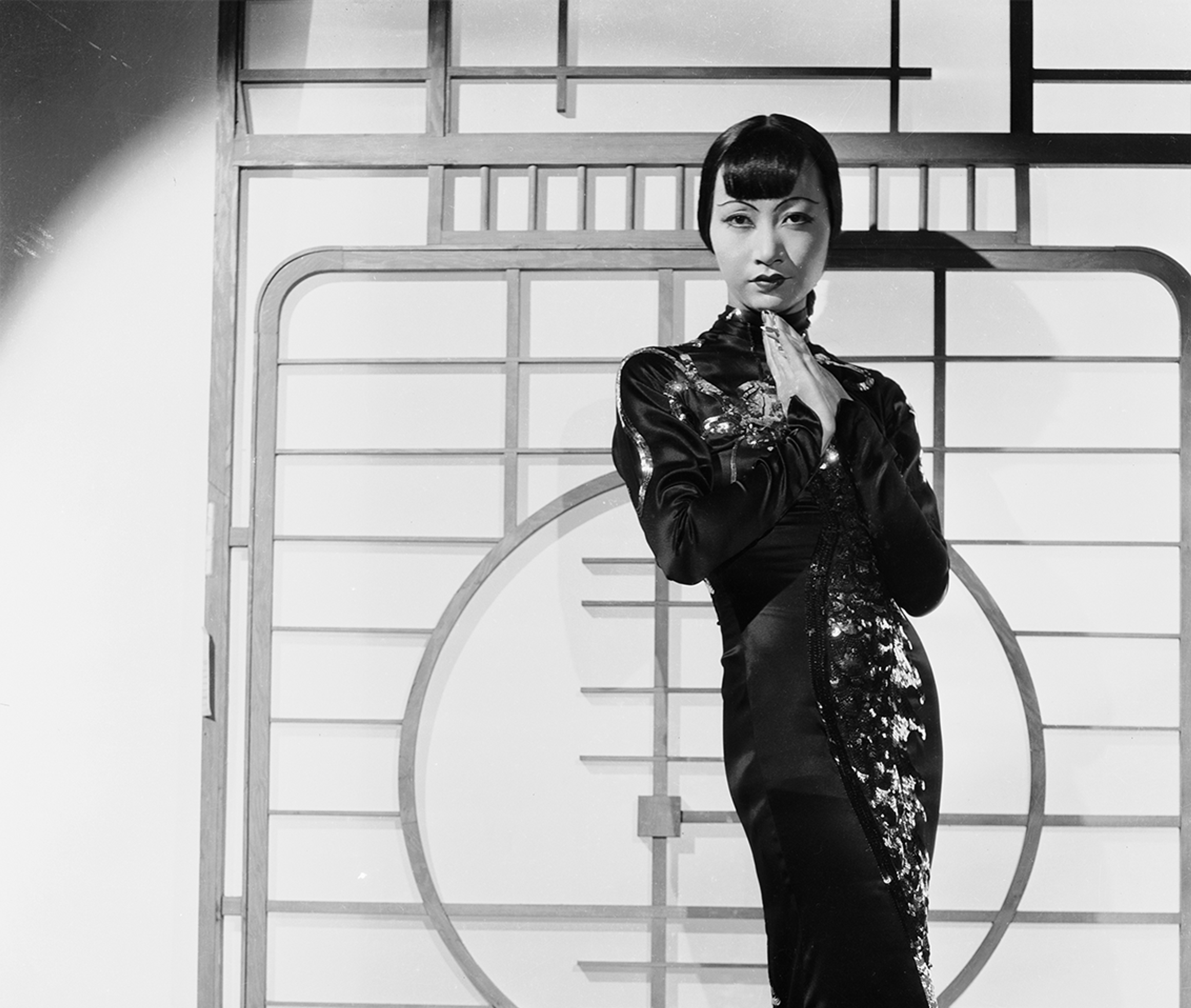Chinese American actor Anna May Wong wore this dress for her role in the 1934 Hollywood film Limehouse Blues, a Paramount drama set in the Limehouse district of London among its significant Chinese immigrant population.[1] She had previously starred in the British film Piccadilly (1929), also set in Limehouse, as an upstart dishwasher turned nightclub dancer. Wong had been periodically living and working since the late 1920s in Europe, where she found opportunity for more substantial roles, as opposed to the stereotyped bit parts she was offered in Hollywood at the beginning of her career. After her success in Piccadilly, Paramount lured Wong back to the United States in 1934 to play the role of Tu Tuan, the strong-willed dancer and mistress of the nightclub owner Harry Young.

Travis Banton (American, 1894–1958). Evening dress, ca. 1934. Black silk charmeuse embroidered with gold and silver sequins. Brooklyn Museum Costume Collection at The Metropolitan Museum of Art, Gift of the Brooklyn Museum, 2009; Gift of Anna May Wong, 1956 (2009.300.1507)
For the first scene in which Tu Tuan appears, undulating sinuously on stage, the costume designer Travis Banton conceived this black, long-sleeved, high-necked dress.[2] It is lavishly embroidered with a gold-and-silver-sequined dragon that runs the length of the entire garment, with the mythical beast’s tail curling around the train and its whiskers and horns splayed across the shoulders.
Banton’s design was part of a new wave of Chinoiserie that swept 1930s Art Deco fashion. The palette evoked the trendy decor of black lacquer screens decorated with gold and silver leaf. His dragon motif was likewise more evocative and fantastical than reflective of the way the symbol was employed in historical Chinese clothing. During the Ming and Qing dynasties, for example, the use of dragons on robes was restricted to the imperial family; they generally appeared in a medallion format among a field of stylized waves and clouds. The creature on Wong’s dress seems to have been inspired by a different kind of object, one that lies at the heart of Chinoiserie—the vase with coiling dragon.

Left: Ming dynasty (1368–1644), Wanli period (1573–1620). Bottle with Coiling Dragon, ca. 1725. Porcelain with transparent glaze (Dehua ware), H. 8 1/4 in. (21 cm). The Metropolitan Museum of Art, New York, Rogers Fund, 1918 (18.56.60). Right: Vienna manufactory (Austrian). Factory director Claudius Innocentius du Paquier period (1718–1744). Vase with coiling dragon, ca. 1725. Hard-paste porcelain with raised decoration painted with colored enamels over transparent glaze, H. 6 1/2 in. (16.5 cm). The Metropolitan Museum of Art, New York, The Hans Syz Collection, Gift of Stephan B. Syz and John D. Syz, 1995 (1995.268.275)
These vases, prevalent during the Ming and Qing dynasties, feature a fully modeled dragon encircling the neck of the vessel, sometimes with its tail wrapped around the body. They were collected in Europe in the eighteenth and nineteenth centuries and subsequently inspired Chinoiserie designs. On Wong’s dress, the golden beast is entwined around her entire figure, its tail extending beyond the body onto the floor, an excess that is a classic marker of Chinoiserie.
The dragon here is, of course, an overdetermined symbol. Not only is it used as a cipher for Chineseness, but it also inevitably suggests a stereotype that began to coalesce around Wong’s persona in the 1930s—the Dragon Lady. The term, referring to an Asian woman who is powerful, alluring, and cruel, came into use in the mid-1930s. It was partly inspired by Wong’s roles, including the seductive and duplicitous Princess Ling Moy in the 1931 film Daughter of the Dragon.[3] Banton’s dress, which seems designed to incarnate this new term, nevertheless became an ambivalent site of resistance to the myriad tropes that inexorably accrued on Wong’s racialized body and image. In this costume, the actor not only is an embodied ceramic vase, but becomes a porcelain idol that could talk back.[4]
In 1933, Wong gave a candid interview in which she criticized the parts she had to play: “Why should we always scheme—rob—kill? I got so weary of it all—of the scenarist’s conception of Chinese character, that I told myself I was done with the films forever.”[5] Although the assertive and relatively sympathetic character of Tu Tuan does not completely escape stereotype—she betrays Harry and kills herself in the end—a hint of Wong’s agency is evident in a publicity photograph for Limehouse Blues featuring The Met’s dress.

Anna May Wong in a publicity photograph for Limehouse Blues, 1934
Wong stands before a backdrop from the Limehouse nightclub set, looking straight out at the viewer. Leaning to form a slight S-curve with her figure, she joins her hands in front of her chest. The angle of her body and the position of her hands render the dragon almost illegible; it becomes a river of sequins as the black silk train pools around her sandaled feet. Her hair is styled not as Tu Tuan but as herself, a fashion icon with her signature bangs.[6] Was this Wong’s way of asserting her own celebrity image over the crystallizing stereotype of the Dragon Lady? Or is this obscuring of the dragon a manifestation of the impossibility of her position—a woman of color playing racialized roles that she could not fully embrace?[7]
The dragon dress is the auratic object in this ambivalent dynamic, where the celluloid image of Wong meets the reality of the individual, physical woman. While the dress is in good condition, it has clearly been worn. Slight tears on the underside of the train and along the sleeves as well as sweat stains along the neckline and armpits are evidence of Wong’s body and labor, of the work she put into pioneering roles for Asian women (even if they were circumscribed by race), promoting her films, and crafting her glamorous image.
In her book Ornamentalism (2018), Anne Anlin Cheng has argued that glamour, which makes the starlet a seductive yet unassimilable object, was particularly liberating for women of color who tended to be both invisible and overly visible in the white European media landscape; it provided relief from navigating individuality in a racialized body and a way to enact agency as an object. In the dragon dress, Wong became a “resistant object” that could address the legacy of Chinoisierie. The worn garment thus likened her to a porcelain vase or black lacquer screen as well as affirming her corporeality. It transformed her into an ornament with a sense of personhood, one that mesmerized and yet thwarted easy consumption of her being. In the dragon dress, Wong became an international icon, encrusted with but extending beyond the aesthetics of Chinoiserie.
Notes
[1] On how Anna May Wong used fashion to construct her image, see Graham Russell Gao Hodges, Anna May Wong: From Laundryman’s Daughter to Hollywood Legend (New York: Palgrave Macmillan, 2004), pp. 129–31; Karen J. Leong, The China Mystique: Pearl S. Buck, Anna May Wong, Mayling Soong, and the Transformation of American Orientalism (Berkeley: University of California Press, 2005), pp. 85–87; Sean Metzger, Chinese Looks: Fashion, Performance, Race (Bloomington: Indiana University Press, 2014), pp. 109–24; and Shirley Jennifer Lim, Anna May Wong: Performing the Modern (Philadelphia: Temple University Press, 2019), pp. 77–79, 101–7, 115–52.
[2] Two versions of this dress were made—one in velvet, which Wong wore in the film, and the silk charmeuse version in The Met, which she wore in publicity images. The dragon on the velvet version has paws with five claws (the number of claws traditionally reserved for imperial objects), while the one in The Met has no paws. On the different purposes and types of film stills and publicity images, see Douglas Gomery, “The Images in Our Minds: Film Stills and Cinema History,” Princeton University Library Chronicle 65, no. 3 (Spring 2004), pp. 502–9.
[3] Yunte Huang, Daughter of the Dragon: Anna May Wong’s Rendezvous with American History (New York: Liveright, 2023), pp. 154–58. See also Cynthia W. Liu, “When Dragon Ladies Die, Do They Come Back as Butterflies? Re-Imagining Anna May Wong,” in Countervisions: Asian American Film Criticism, ed. Darrell Y. Hamamoto and Sandra Liu (Philadelphia: Temple University Press, 2000), pp. 23–40.
[4] On the conflation of Chinese female bodies and porcelain, see Anne Anlin Cheng, Ornamentalism (New York: Oxford University Press, 2019), pp. 93–96.
[5] Anna May Wong, “I Protest,” interview by Doris Mackie, Film Weekly, August 18, 1933, p. 11.
[6] Wong was voted best-dressed woman in the world by the Mayfair Mannequin Society in New York in 1934, the same year Limehouse Blues came out.
[7] I am grateful to Iris Moon for suggesting this interpretation.
This essay is adapted from the catalogue Monstrous Beauty: A Feminist Revision of Chinoiserie, which accompanies an exhibition on view through August 17, 2025.
